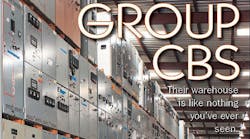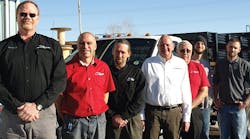Not all that long ago, family-owned, independent electrical distributors controlled much of the market in the upper Midwest. With some blockbuster acquisitions in recent years by Sonepar and other regional distributors, that's all changed. Still, a few independents, like 57-year-old Minnesota Electric, continue to thrive.
What's the secret? For Minnesota Electric, the recipe's ingredients are simple. At the heart of the formula are strong rural, family-friendly roots.
“It sounds kind of corny, maybe,” said Steve Peterson, president, “but we're a family business. We take a lot of pride in the fact that we are a family business serving other family businesses. We work real hard to just stay the course and not get all wrapped up in a lot of industry mumbo-jumbo.”
This third-generation family-owned business got its start in 1945 selling electrical appliances. Two years later it took a turn toward electrical distribution. Now, 57 years after opening its doors, Minnesota Electric has grown to eight branches with annual sales of more than $54 million.
For most of those years, Linder family members took the driving seat. But, six years ago, when second-generation Steve Linder retired as president, Minnesota Electric recruited Steve Peterson to take the leadership reigns. Although Steve Linder still plays a role at Minnesota Electric as chairman and head of the board of directors, overall, Peterson now directs the show.
“I'm a hired gun,” said Peterson. “I'm hired to run their company for them. My marching orders from the family are simple: grow the business and increase market share. That's what we've done.”
Peterson's resume reads like a Who's Who in upper Midwest electrical distribution. His 34 years of electrical industry experience include stints with several distributors and five years as a manufacturer's rep. Starting his career with Northland Electric back in 1968, Peterson has also worked for Progressive Electric, Lappin Electric, Sterling Electric and J.H. Larson Electrical Co.
Ironically, only two of the five electrical distributors where he honed his skills remain independent distributors. “When you look at Minnesota, northern South Dakota and western Wisconsin, it was all independent distributors at one time,” said Peterson. “With consolidation, that's changing.
Lappin Electric was acquired by Consolidated Electrical Distributors (CED), Westlake Village, Calif.; Sterling Electric was purchased by Border States, Fargo, N.D.; and Northland was acquired in a joint venture by Van Meter Industrial, Cedar Rapids, Iowa, and Werner Electric Supply, Neenah, Wis., in 2001. Interestingly, Werner had planned on acquiring Van Meter as well as Northland last year but left a provision in the letter of intent allowing for poor economic conditions. So, instead Werner and Van Meter are 50 percent owners of Northland.
In another acquisition in the Twin Cities, Sonepar purchased Viking Electric Supply Inc., St. Paul, Minn., in 2000. About the same time Sonepar moved into the market, Minnesota Electric made its move, too, with the acquisition of Judd Supply Co., Coon Rapids, Minn., a suburb of Minneapolis.
“Culturally, Judd fit nicely with Minnesota Electric's emphasis on the electrical customer,” said Peterson. “Ninety-five percent of Judd's business was contractor-oriented. Our focus is on contractors. That's our interest, and that's what we focus on.”
The Judd acquisition — the company's first move from the rural Minnesota market into a metro area — played a valuable role in helping Minnesota Electric achieve some of its growth goals. The size of the company has nearly doubled since Peterson took the helm six years ago. In 1996, Minnesota Electric's six branches did $31 million in sales. By 2001, sales soared to $58 million, and the distributor had added two branches, bringing the total to eight.
With the exception of the acquired Coon Rapids branch, all are in relatively small rural Minnesota towns with populations ranging from 8,000 to 49,000. From any branch location, the nearest branch is about 100 miles away.
The road trips between branches are much like the 100-mile trip from the Twin Cities to Minnesota Electric's Willmar, Minn., headquarters. The two-lane highway, dotted every seven-miles-or-so with a slow-to-35 small-town-USA, takes one back to a simpler time. With a population of 19,000, Willmar is nothing more than a big small town.
Some might wonder just how a distributorship serving rural Minnesota has managed to make its way to the No. 88 spot on Electrical Wholesaling's list of the 250 largest electrical distributors.
“We're very traditional,” said Peterson. “We service all the local little electricians — mom and pop businesses.” On average, those electrical contractors have less than 10 people working for them and focus on residential and commercial work.
Any industrial, utility and institutional business that Minnesota Electric does is more by accident than design. “When you're in these rural areas, the local co-op, municipality or the hospital is always going to do some business with you,” said Peterson.
Being an electrical distributor in the rural Midwest also naturally means doing business with food companies that process turkey and sugar beets. “We do have a few people that call on some of those accounts, but our focus is on contractors. That's our interest, and that's what we focus on.”
With more than 4,000 active electrical-contractor customers, the folks at Minnesota Electric stay busy. “We spend a lot of time trying to get out to customers,” said Peterson. As a result, Peterson and his supporting cast log many miles visiting customers and branches. “I'll put on 45,000 to 50,000 miles a year,” said Peterson. Roy Stoel, vice president of sales, logs about 60,000 miles per year.
On average, Peterson and Stoel spend only a couple of days in the office each week. They're on the road the rest of the time visiting customers or the branches.
“I think that is a unique thing that independents do,” said Peterson. “The president of one of the 800-pound gorillas is lucky if he even gets to his branches, but we're at our branches and out with customers all the time.”
Another thing that Peterson says sets many independents apart from the national chains is having adequate inventory at the branch level to service the local market.
“Some consultants might advise not stocking those slow-moving items,” Peterson chuckled. “But when someone needs that slow-moving product, that's what separates us from the guy in the cities who can ship it out the next day.
“What holds us back the most is our vendors. That's going to come across sounding pretty negative against manufacturers, but that is not my intention. Manufacturers are driven by Wall Street; they're driven by a quarterly stock value. They are driven by increasing those sales to the degree that they have to keep the big guys — the 800-pound gorillas — happy. I think we have become a pretty small number to them a lot of times.”
Well, small is relative. Enough small sales of traditional electrical materials can add up to some big numbers.
“We're straight conduit and wire, boxes and fittings, and commercial light fixtures,” said Peterson. “We're not into any of the exotic stuff at all.”
Sure, Minnesota Electric carries datacom wire and provides training seminars. Still, most of its electrical contractor customers aren't too interested. “They pull the wire now and then, but that's about as far as they go with most of it,” said Peterson. “It's a small part of our business. It will grow slowly with time.”
Minnesota Electric also expects its e-sales Web site, which went up last October, to grow slowly with time. “It's real successful in some respects,” said Peterson. “We're finding customers use it for a lot of different stuff, but they're not necessarily placing orders on it.” Instead, customers still call and fax orders in.
The electrician that owns a shop and works in the field all day is probably going to keep doing things the way he's always done them, said Peterson. “He's still going to show up at the counter to place an order and have a sweet roll. That's reality. But, back in his office, he's got a young lady doing his books for him. Well, she's out on the Web getting invoices and checking on back orders.
“From a technology standpoint, we work very hard to keep ourselves on the leading edge, so when our customers are ready, we can support them,” said Peterson.
Some of that support has meant constructing a dynamic team to consider customer and employees needs for both today and tomorrow. When Peterson came on board, he added a full-time director of marketing and human resources director.
“If you're a $25-million-a-year-distributor, you can't afford marketing or HR people, so management wears several different hats. As we've gotten bigger, we've added those resources to hopefully continue to help us compete.”
Competing has also meant implementing basic business tools — like making sure that every employee, including the truck driver in the warehouse, has e-mail and Internet access and by upgrading from the SHIMS business software program to NxTrends.
“We're all Windows-based now, and it's a full ERP system, so everything is integrated. We can produce financial statements every hour on the hour,” said Peterson. “Everything is tied together and balanced daily. You can run reports 'til it drives you crazy sometimes.
“Has that helped us any? I think it's made us become more disciplined. These new systems of today are pretty unforgiving. You've got to embrace them 110 percent. You've got to train everyone, and you've got to work with them. I think we've done that successfully.”
To compete in the upper Midwest market, it was a necessity. “Every distributor in this market area that I can think of has put in a new computer system and software package within the last couple of years. Everyone.”
What everyone has not done is continue to grow revenues. During the last year, when the depressed economy forced many electrical distributors to downsize personnel and branches, Minnesota Electric Supply was among a handful of distributors that stood their ground.
Still, competing during this recession may be a bit easier in the upper Midwest than for electrical distributors in other parts of the country.
“We're fortunate here in Minnesota in the market that we serve because we don't have the peaks, and we don't have the dips,” said Peterson. “When it's hot on the East Coast or West Coast, they are hot. They're up 30 to 40 percent from one year to the next. But, when they're down, they're down the same way.”
Another reason Minnesota Electric has held its own since the recession, is because it plays smart. “One of the reasons we had a better year (than other distributors) is because we're pretty lean and mean. We don't have a lot of overhead.”
With a management team of just five people, a small corporate staff, and branches managed with low overhead, Minnesota Electric didn't have any of the layoffs or wage cuts this last year, like some distributors in its market.
“Our market is strictly servicing the electrical contractor,” said Peterson. “That's where we spend all our energy and devote all our time. If we keep doing that, I think we can keep the 800-pound gorillas at bay. We think we do pretty well.”
MINNESOTA ELECTRIC FAST FACTS
Market
The 57-year-old rural-Minnesota distributor almost exclusively caters to small electrical contractors that serve the residential and commercial markets. The industrial, utility and institutional business that Minnesota Electric does is more by accident than by design. “Our focus is on contractors,” says Steve Peterson, president. “That's our interest and that's what we focus on.”
Family Owned
“The family's real motivation to continue in the industry with all of the consolidation going on is that they want to keep grandpa's dream going, and they are very committed to the employees and customers,” said Peterson. “We get (acquisition) offers all the time.”
2001 Sales: $58,137,000
Branch Locations: eight
Number of Employees: 130
Inventory: $9 million in inventory








